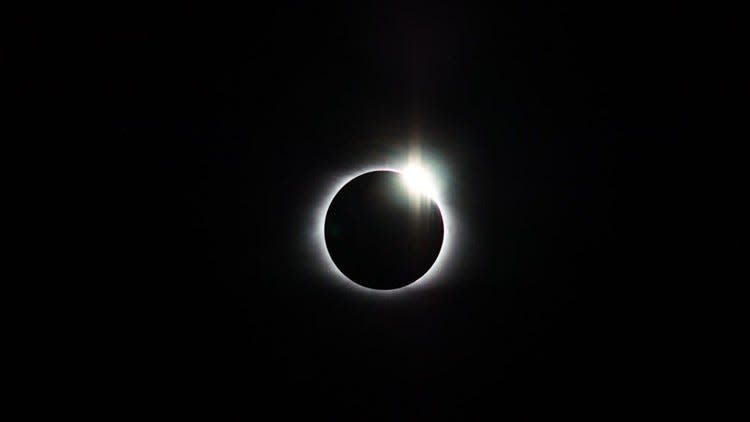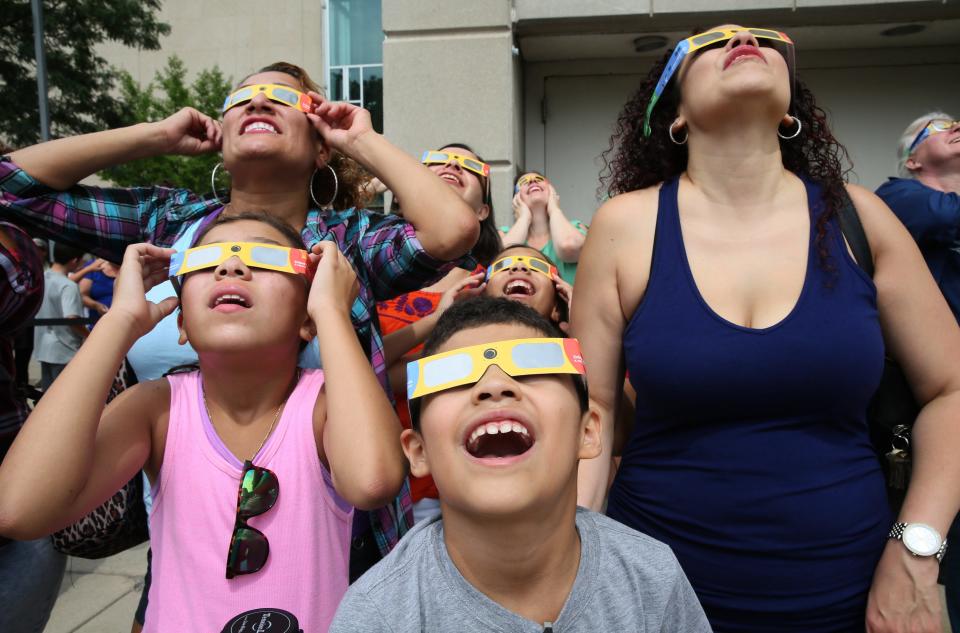What time is the solar eclipse happening today in Wisconsin? Find out here with your ZIP code
The biggest astronomical event of the year is almost here.
On Monday, April 8, 2024, the "Great American Eclipse" will turn day to night for a few brief minutes as the moon blocks the sun's light along a 115-mile-wide, southwest-to-northeast path across the continent.
Millions of people in 13 states stretching from Texas to Maine will experience this nighttime-like darkness under the eclipse's "path of totality." The rest of the United States, including Milwaukee and all of Wisconsin, is outside the path and will experience a partial solar eclipse.
Timelapse, map, peak: How long is the solar eclipse in Wisconsin?
A partial eclipse is less noticeable (instead of darkness, its peak effects are said to resemble an overcast day), but you can still watch the moon cover part of the sun from Wisconsin. Just make sure to do so safely, using eye-protective solar eclipse glasses.
What time is the eclipse? How long will it last? What will it look like?
Enter your ZIP code to see when the solar eclipse will reach your area and for how long, as well as what percent of the sun will be obscured at the eclipse's peak.
Can't see our graphics? What time is the solar eclipse? Search your ZIP code for a viewing guide
When can I see the solar eclipse from southern Wisconsin?
Here is the solar eclipse information skywatchers need to know if they plan to view the eclipse from one of southern Wisconsin's major cities:
Platteville ― 12:49 p.m. to 3:18 p.m.
As the eclipse travels along its southwest-to-northeast path across the country, cities in western Wisconsin will see it slightly before the Milwaukee area. Platteville will experience the partial solar eclipse from 12:49:20 p.m. to 3:18:30 p.m. The eclipse will reach its peak at 2:04:30 p.m. when the moon covers 86% of the sun. Platteville residents can see the eclipse at 50% of its peak coverage at 1:29:20 p.m. and again at 2:39:30 p.m.
Richland Center ― 12:50 p.m. to 3:18 p.m.
Richland Center will experience the partial solar eclipse from 12:50:30 p.m. to 3:18:40 p.m. It will reach its peak at 2:05:10 p.m., and the moon will cover 84% of the sun. The eclipse will be at 50% of its peak coverage at 1:29:50 p.m. and again at 2:40:10 p.m. in Richland Center.
Madison ― 12:51 p.m. to 3:19 p.m.
Wisconsin's capital city will see the partial eclipse from 12:51:10 p.m. to 3:19:50 p.m. The eclipse will reach its peak in Madison at 2:06:10 p.m. when the moon covers 86% of the sun. Madisonians can see the eclipse at 50% of its maximum coverage at 1:31:10 p.m. and 2:40:50 p.m.
Janesville ― 12:51 p.m. to 3:20 p.m.
Janesville will experience the eclipse from 12:51:10 p.m. to 3:20:20 p.m. The eclipse will peak at 2:06:30 p.m., and the moon will cover 88% of the sun. The eclipse will be at 50% of its peak coverage at 1:31:50 p.m. and again at 2:40:50 p.m.

Waukesha ― 12:52 p.m. to 3:21 p.m.
Waukesha will see the partial solar eclipse from 12:52:30 p.m. to 3:21:20 p.m. It will reach its peak at 2:07:40 p.m. when the moon covers 89% of the sun. Waukesha skywatchers can view the eclipse at 50% of its maximum coverage at 1:33:10 p.m. and again at 2:42:00 p.m.
Kenosha ― 12:52 p.m. to 3:21 p.m.
Cities in southeastern Wisconsin are closer to the path of totality than those in the west and will perhaps see more noticeable overcast skies during the partial eclipse's peak. Kenosha will experience the eclipse from 12:52:30 p.m. to 3:21:50 p.m. The eclipse will reach its peak at 2:08:00 p.m., and the moon will cover 91% of the sun. Kenosha residents can see the eclipse at 50% of its maximum coverage at 1:33:40 p.m. and 2:41:50 p.m.
Milwaukee ― 12:53 p.m. to 3:21 p.m.
Milwaukee will see the partial solar eclipse from 12:53:00 p.m. to 3:21:50 p.m. The city will experience the eclipse's peak coverage at 2:08:10 p.m. The moon will cover 89% of the sun. The eclipse will be at 50% of its maximum coverage in Milwaukee at 1:33:50 p.m. and again at 2:42:20 p.m.

When can I see the solar eclipse from my Wisconsin city?
Use this map and zoom in to determine when your city will see the peak total or partial solar eclipse on Monday, April 8.
Note: Zoom in and click on the map below to see where and when the solar eclipse will peak in your area. For example, if you click on Milwaukee, you'll see the peak time will be at 2:08:10 p.m.
Local eclipse watches: Can't travel for the April 8 solar eclipse? Experience it at these Milwaukee eclipse events
Eclipse travel info: Where is the closest city to Milwaukee to view the 2024 total solar eclipse?
This article originally appeared on Milwaukee Journal Sentinel: What time is the solar eclipse in Wisconsin? Search Zip code on map

